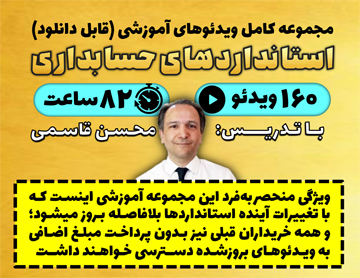پیش فرض ارزشیابی برای داراییهای غیرمالی
(استاندارد حسابداری 42 اندازهگیری ارزش منصفانه (مصوب 1399))
31. بیشترین و بهترین استفاده از دارایی غیرمالی، تعیینکننده پیشفرض ارزشیابی مورد استفاده در اندازهگیری ارزش منصفانه دارایی به شرح زیر است:
الف. بیشترین و بهترین استفاده از دارایی غیرمالی، ممكن است از طریق استفاده از آن دارایی در ترکیب با سایر داراییها به عنوان یک گروه (پس از نصب یا سایر شیوههای آمادهسازی برای استفاده) یا در ترکیب با سایر داراییها و بدهیها (برای مثال، یك فعالیت تجاری)، حداكثر ارزش را برای فعالان بازار ایجاد كند.
1. اگر بیشترین و بهترین استفاده از دارایی، استفاده از دارایی در ترکیب با سایر داراییها یا در ترکیب با سایر داراییها و بدهیها باشد، ارزش منصفانه دارایی قیمتی است که در یک معامله جاری بابت فروش دارایی دریافت میشود، با این فرض که آن دارایی همراه با سایر داراییها، یا همراه با سایر داراییها و بدهیها مورد استفاده قرار میگیرد و داراییها و بدهیهای مزبور (یعنی داراییهای مکمل و بدهیهای مربوط به آن) در دسترس فعالان بازار است.
2. بدهیهای مرتبط با دارایی مزبور و بدهیهای مرتبط با داراییهای مکمل، شامل بدهیهایی است که سرمایه در گردش را تأمین میكند، اما شامل بدهیهای مورد استفاده برای تأمین مالی داراییهایی به غیر از گروه داراییها نمیشود.
3. مفروضات مربوط به بیشترین و بهترین استفاده از دارایی غیرمالی، باید برای تمام داراییها (که بیشترین و بهترین استفاده در مورد آنها مربوط است) در گروه داراییها یا گروه داراییها و بدهیها كه دارایی در آن گروه مورد استفاده قرار میگیرد، متناقض نباشد.
ب. بیشترین و بهترین استفاده از یک دارایی غیرمالی ممكن است بر مبنای استفاده مستقل از دارایی، حداکثر ارزش را برای فعالان بازار فراهم كند. اگر بیشترین و بهترین استفاده از دارایی، بر مبنای استفاده مستقل از دارایی باشد، ارزش منصفانه دارایی، قیمتی است که در معامله جاری، بابت فروش دارایی به فعالان بازار كه دارایی را به صورت مستقل مورد استفاده قرار میدهند، دریافت میشود.
32. در اندازهگیری ارزش منصفانه یک دارایی غیرمالی، فرض میشود که دارایی مطابق با واحد حساب مشخصشده در سایر استانداردهای حسابداری (که ممکن است یک دارایی منفرد باشد) به فروش میرسد. این موضوع حتی هنگامی که در اندازهگیری ارزش منصفانه فرض میشود بیشترین و بهترین استفاده از دارایی از طریق ترکیب با سایر داراییها یا از طریق ترکیب با سایر داراییها و بدهیها بهدست میآید، مصداق دارد، زیرا در اندازهگیری ارزش منصفانه فرض بر این است که فعالان بازار، داراییهای مکمل و بدهیهای مربوط به آن را در حال حاضر در اختیار دارند.
33. بند ب3 [ به شرح زیر ] کاربرد مفهوم پیشفرض ارزشیابی برای داراییهای غیرمالی را تشریح میکند.
ب3. تأثیر پیشفرض ارزشیابی هنگام اندازهگیری ارزش منصفانه دارایی غیرمالی که در ترکیب با سایر داراییها به عنوان یک گروه (پس از نصب یا سایر شیوههای آمادهسازی برای استفاده) یا در ترکیب با سایر داراییها و بدهیها (برای مثال، یک فعالیت تجاری) استفاده میشود، بستگی به شرایط دارد. برای مثال: الف. یک دارایی، صرفنظر از اینکه بطور مستقل یا در ترکیب با سایر داراییها یا در ترکیب با سایر داراییها و بدهیها مورد استفاده قرار گیرد، ارزش منصفانه آن ممکن است یکسان باشد. این موضوع ممکن است در شرایطی مصداق داشته باشد که دارایی مورد نظر، یک فعالیت تجاری باشد که فعالان بازار آن فعالیت را ادامه میدهند. در این صورت، معامله مستلزم ارزشیابی کلیت فعالیت تجاری است. استفاده از داراییها به عنوان یک گروه در یك فعالیت تجاری دارای تداوم، موجب همافزاییهایی میشود که در دسترس فعالان بازار خواهد بود (یعنی همافزاییهای فعالان بازار که به این ترتیب، باید بر ارزش منصفانه دارایی مستقل یا دارایی در تركیب با سایر داراییها یا در تركیب با سایر داراییها و بدهیها اثر بگذارد). ب. استفاده از یک دارایی در ترکیب با سایر داراییها یا در ترکیب با سایر داراییها و بدهیها ممکن است از طریق تعدیل ارزش آن دارایی، در صورت استفاده بطور مستقل، در اندازهگیری ارزش منصفانه لحاظ شود. این موضوع ممکن است در شرایطی مصداق داشته باشد که دارایی مورد نظر یک دستگاه ماشینآلات است و اندازهگیری ارزش منصفانه آن با استفاده از قیمت مشاهدهشده برای ماشینآلات مشابه (نصب نشده یا به شیوهای دیگر، آماده استفاده نیست)، پس از تعدیل بابت مخارج حمل و نصب انجام میشود، بهگونهای که اندازهگیری ارزش منصفانه، وضعیت و موقعیت مکانی فعلی ماشینآلات (نصبشده و آمادهسازیشده برای استفاده) را منعكس میكند. پ. استفاده از یک دارایی در ترکیب با سایر داراییها یا در ترکیب با سایر داراییها و بدهیها ممکن است از طریق مفروضات مورد استفاده فعالان بازار برای اندازهگیری ارزش منصفانه آن دارایی، در اندازهگیری ارزش منصفانه لحاظ شود. برای مثال، اگر دارایی، کالای در جریان ساخت خاصی است که فعالان بازار آن را به محصول نهایی تبدیل میکنند، در اندازهگیری ارزش منصفانه آن موجودی کالا فرض میشود که فعالان بازار، ماشینآلات تخصصی لازم برای تبدیل آن کالای در جریان ساخت به محصول نهایی را تحصیل کردهاند یا تحصیل میكنند. ت. استفاده از یک دارایی در ترکیب با سایر داراییها یا در ترکیب با سایر داراییها و بدهیها ممکن است در تکنیک ارزشیابی مورد استفاده برای اندازهگیری ارزش منصفانه آن دارایی لحاظ شود. این موضوع ممكن است در شرایطی مصداق داشته باشد که از روش عایدات مازاد چنددورهای برای اندازهگیری ارزش منصفانه یک دارایی نامشهود استفاده شود، زیرا در این تکنیک ارزشیابی، مشارکت هرگونه دارایی مکمل و بدهی مربوط در گروهی که از چنین دارایی نامشهودی استفاده میشود، بطور خاص در نظر گرفته میشود. ث. در وضعیتهای محدودتر، هنگامی که واحد تجاری از یک دارایی موجود در گروهی از داراییها استفاده میکند، واحد تجاری ممکن است با تخصیص ارزش منصفانه گروه داراییها به هر یک از داراییهای آن گروه، دارایی مزبور را به مبلغی نزدیک به ارزش منصفانه آن اندازهگیری كند. این موضوع ممکن است در شرایطی مصداق داشته باشد كه ارزشیابی، دربردارنده املاک باشد و ارزش منصفانه املاك بهسازیشده (یعنی گروه دارایی) به داراییهای تشكیلدهنده آن (مانند زمین و مستحدثات) تخصیص یابد. |
Valuation premise for non-financial assets (IFRS 13 Fair Value Measurement)
31 | The highest and best use of a non‑financial asset establishes the valuation premise used to measure the fair value of the asset, as follows:
|
32 | The fair value measurement of a non‑financial asset assumes that the asset is sold consistently with the unit of account specified in other IFRSs (which may be an individual asset). That is the case even when that fair value measurement assumes that the highest and best use of the asset is to use it in combination with other assets or with other assets and liabilities because a fair value measurement assumes that the market participant already holds the complementary assets and the associated liabilities. |
33 | Paragraph B3 describes the application of the valuation premise concept for non‑financial assets. |
| B3 | When measuring the fair value of a non‑financial asset used in combination with other assets as a group (as installed or otherwise configured for use) or in combination with other assets and liabilities (eg a business), the effect of the valuation premise depends on the circumstances. For example:
|







دیدگاه خود را بنویسید